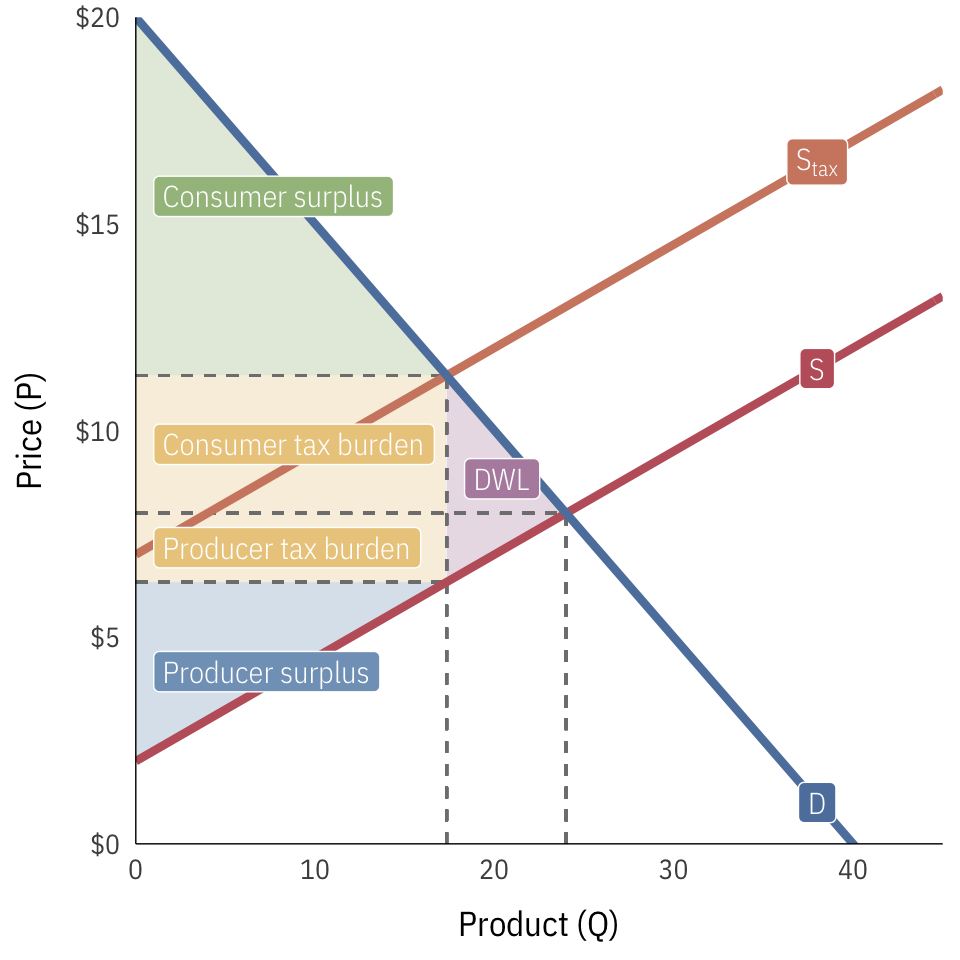Exam 2 study guide
Firms and markets
You should understand…
- …how demand curves are derived from consumer willingness to pay
- …the difference between fixed costs and variable costs
- …how to calculate total cost, total revenue, average fixed costs, average variable costs, marginal cost, marginal revenue, and maximum profit
- …that maximum profit occurs where marginal revenue is equal to marginal cost ($MR = MC$)
- …that socially optimal quantity occurs when the demand is equal to the marginal cost ($\text{demand} = MC$)
- …how to calculate elasticity of demand ($-\frac{\Delta Q}{\Delta P} \times \frac{P}{Q}$)
- …what elasticity measures and why it is important in public policy and administration
- …how a single demand curve can have an overall elasticity and different elasticities at each point
- …economies of scale, diseconomies of scale, economies of agglomeration, network effects, and the difference between short-run and long-run costs
- …that market equilibria (i.e. optimal price and quantity) occur at the intersection of supply and demand curves
- …how government-imposed price floors and price ceilings distort market-clearing equilibria
- …and be able to identify the differences between changes in supply/demand and changes in quantity supplied/demanded
- …what consumer and producer surplus represent
- …the relationship between elasticity of supply and/or demand and the size of consumer and producer surplus
- …how taxes impose deadweight loss on society
- …how the burden of taxes depends on the elasticity of supply and/or demand
- …why governments tax and the philosophical and ethical principles behind who should bear the burden of taxes
- …the difference between price-taking and price-making
- …how firms try to gain market power, including monopolies, branding, cost controls, regulation, and switching costs
- …why firms try to gain market power
- …why firms want to price discriminate
- …the consequences of monopolistic production (lower Q and higher P than what would happen under perfect competition; deadweight loss)
- …how governments can regulate monopolies
- …why natural monopolies exist and how governments can induce them to produce at socially optimal levels
- …how firms need to be somewhat anti-competitive and anti-capitalist in order to maximize profits, innovate, and (essentially) be more competitive and capitalist
Guides
Important formulas:
-
Demand:
$$ P = aQ + b $$
-
Total cost:
$$ \begin{aligned} TC = TFC + TVC \\
\text{or a formula using } Q \text{, like} \\
TC = aQ^2 + b \end{aligned} $$ -
Average cost:
$$ AC = \frac{TC}{Q} $$
-
Marginal cost:
$$ \begin{aligned} MC &= \frac{\Delta TC}{\Delta Q} \\
&\text{or} \\
MC &= \text{First derivative of TC} \\
&= 2aQ \text{ (if } TC = aQ^2 + b) \end{aligned} $$ -
Total revenue:
$$ \begin{aligned} TR &= PQ \\
&\text{or} \\
TR &= (aQ + b)Q \\
&= aQ^2 + bQ \end{aligned} $$ -
Average revenue:
$$ AR = \frac{TR}{Q} $$
-
Marginal revenue:
$$ \begin{aligned} MR &= \frac{\Delta TR}{\Delta Q} \\
&\text{or} \\
MR &= \text{First derivative of TR} \\
&= 2aQ + b \text{ (if } TR = aQ^2 + bQ) \end{aligned} $$ -
Maximum profit:
$$ max(\pi): MC = MR $$
-
Price elasticity of demand (see this guide of how to get to
\(- \frac{\Delta Q}{\Delta P} \times \frac{P}{Q}\)):$$ \varepsilon = -\frac{\% \text{ change in quantity demand}}{\% \text{ change in price}} = - \frac{\Delta Q}{\Delta P} \times \frac{P}{Q} $$
Important graphs:
-
Consumer surplus, producer surplus, tax revenues, tax burdens, and deadweight loss (use algebra and geometry to figure out the areas of the triangles ($\frac{1}{2} \times b \times h$) and rectangles ($l \times w$)):

Helpful resources:
- Derivatives of Exponential Functions (how to calculate derivatives quickly)
- Jason Welker, “Natural Monopoly and the Need for Government Regulation”
Institutions, power, and inequality
You should understand…
- …why institutions matter for public administration, policy, and governance
- …the strengths and weaknesses of and the and general differences between three main theoretical approaches to institutions: institutions as rational behavior, institutions as constraints, and institutions as temporary equilibria
- …the difference between informal and formal institutions
- …why informal institutions exert influence over our actions even if they’re not officially codified
- …the difference between self-enforcing, self-reinforcing, and self-undermining institutions
- …the role of path dependency in the emergence of institutions
Market and government failures
You should understand…
- …the difference between private goods, club goods, common pool resources, and public goods (and how they can be classified as (non)rivalrous and (non)excludable)
- …what a market failure is
- …what a government failure is
- …what public goods are and how governments, the private sector, and informal institutions can address them
- …what common pool resources (CPRs) are and how governments, the private sector, and informal institutions can address them
- …the difference between social and private marginal cost (supply) and marginal benefit (demand)
- …what externalities are and how governments, the private sector, and informal institutions can address them
- …what Coasian bargaining is, when it is advantageous, and why it sometimes fails
- …how cap and trade systems can fix externalities (and when they can’t)
- …how Pigouvian taxes can fix externalities (and when they can’t)
- …how regulation can fix externalities (and when and why it can’t)
- …the difference between income and assets
- …why shared national identity and strong horizontal networks of institutions are important for a country’s social and economic wellbeing
- …how inequitable public policies lead to decreased public goods provision, unequal institutional access, and increased ethnofractionalization
- …why slavery and white supremacy have had lasting institutional impacts on the economic system of today and how government policies have contributed to these consequences (specifically in housing and education)